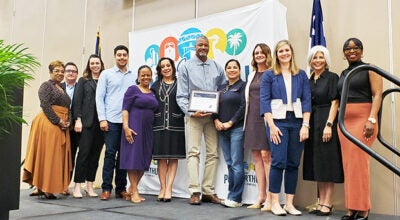Forum held for big-storm readiness
Published 10:36 am Wednesday, August 24, 2016
What would you do if you had to expect the worse? If a hurricane came into the Gulf and was expected to hit along the Southeast Texas coastline? Would you be prepared? Would you be insured? Would you know which evacuation routes to take? These are some of the questions that Mark Hanna would want you to consider.
Hanna, spokesperson for the Insurance Council of Texas (ICT), is on his 11th annual tour of the Texas Gulf Coast to warn coastal residents of the potential danger of hurricanes and what they can do to prepare for such a storm. He is teaming with various meteorologists from the National Weather Service to spread his message of preparedness to Texas residents along the coast, from Port Arthur all the way down to Brownsville.
“If you live along the Texas coastline, you need three different kinds of insurance,” Hanna said. “No. 1: a windstorm policy as provided by Texas Windstorm Insurance Association (TWIA); No. 2: a flood insurance policy… and No. 3: a homeowner policy that covers fire, theft, and liability.”
Hanna was quick to point to the recent flooding in Louisiana as additional reason for why certain Texans should invest in, or least consider, insurance.
“Look at Louisiana,” Hanna said. “They got 30 inches or more of rain, and the majority of them had no flood policy.
“But if your house gets lost to floods, where do you turn? What do you do?”
Complacency was not an excuse for Hanna either, who stressed planning and preparedness.
“There are generations of Texans living in certain areas along our coastline who have never seen the affects of a hurricane,” Hanna said. “Our coastal tour is a reminder to all homeowners and businesses that they should be fully prepared for the onslaught of a hurricane by checking their insurance coverage and having an evacuation plan in place.”
The ICT spokesman made it clear that he was not selling insurance; he was giving out education.
“I’m here for insurance education,” Hanna said. “I want people to have an evacuation plan first, then we’ll talk about insurance.
“I would hope that Louisiana would spur them to look at the homeowners with no insurance and think twice. If nothing else, to at least consider it.”
Roger Erikson, meteorologist for the National Weather Service (NWS) in Lake Charles, agreed that a certain level of readiness is desirable and that that readiness comes about from the best possible information at the time.
“We work closely with local officials to find out their timelines [to evacuate], and we make sure that they have the best information possible to make those kinds of decisions for the city.”
Erikson complemented the offices in the region. He said, “Local officials have hard decisions to make — when to order evacuation, how to do it, what timeline they have to work with…
“One of the good things about Southeast Texas is that they have a good network of elected officials to make [these decisions]. We work with local media to get the word out and give local offices what they need.”
Still, having a plan in place is only part of being prepared in Hanna’s opinion.
“We’ve gone eight years without a hurricane. We’re getting to the point along the Texas coast where we’re overdue. Just consider the worst-case scenario, just talk to an agent. It’s a free phone call. See about estimates.”
Erikson advised against any “false sense of security” in the Port Arthur area that the seawall may give.
“You have the seawall and a levee system, but you have to ask yourself: How well does it protect?’ Against a Category 1 [hurricane], yes; but, against a Category 2 or higher? Water almost came over the levee against a strong Cat 2.
“I hope people would understand that even a Category 2 could flood areas.”
In Hanna’s opinion, the people of Southeast Texas would certainly be aware of it.
“People here stay aware. They seem very educated when it comes to weather events. If they’re that educated, they should have insurance.”
The hurricane tour is scheduled to include meteorologists from NWS offices that run along the Texas coastline: Erikson from Lake Charles, Dan Reilly from League City, John Metz from Corpus Christi and Barry Goldsmith from Brownsville.
Hanna will be working with an interpreter to handle all Spanish interviews. Brochures entitled “Lessons Learned: Texas Hurricanes” that spotlight damage done by three separate hurricanes and gives out evacuation and insurance recommendations for homeowners will be given out in both English and Spanish.
The tour is scheduled to make stops in Port Arthur, Beaumont, Orange, Houston, Baytown, Pasadena, Galveston, Clute, Bay City, Victoria, Port Lavaca, Rockport, Port Aransas, Corpus Christi, Kingsville, McAllen, Harlingen and Brownsville.
For more information, visit www.insurancecouncil.org.





